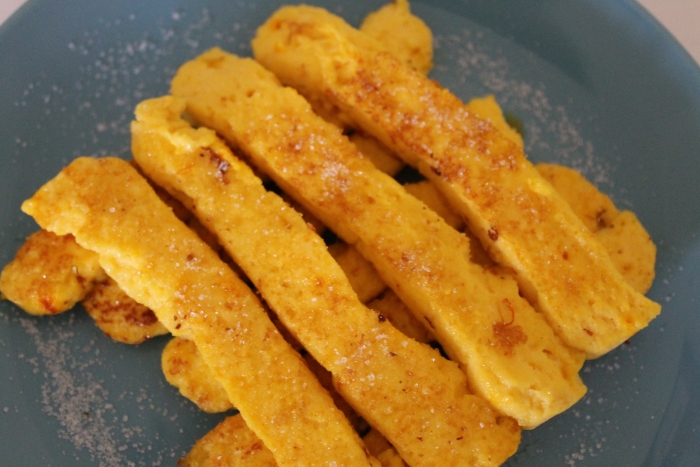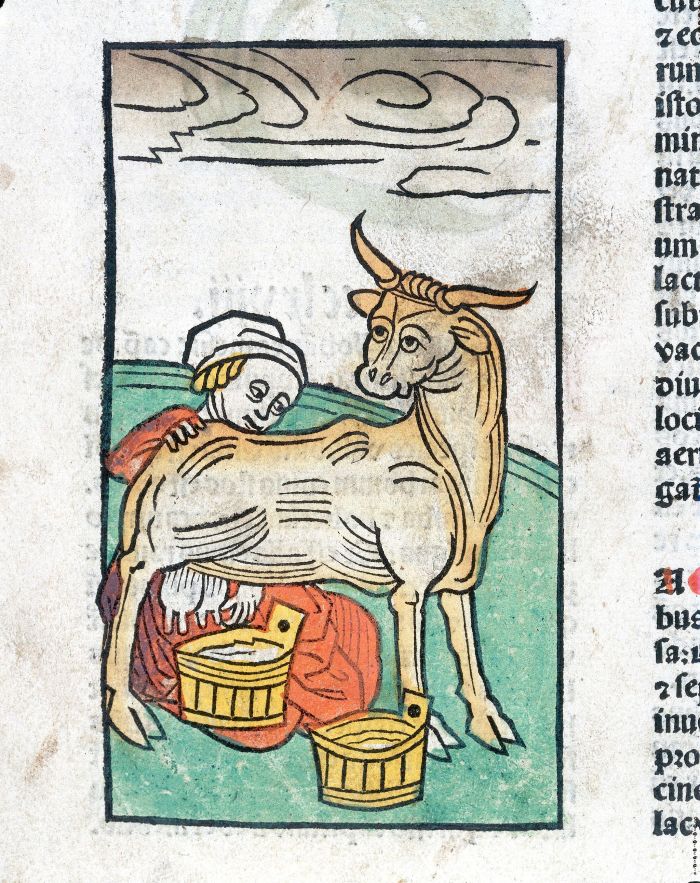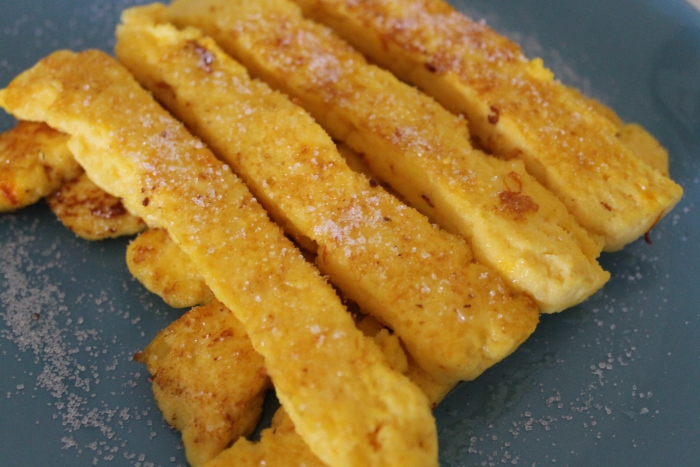
So catching up on missed challenges, here is my HFF entry for ‘Roasts’. Of course, I couldn’t just do a normal roast could I? and so I present to you a recipe for Roasted Milk.
Yes, you read that right, I said Roasted Milk. You may be wondering, as did I, exactly how one roasts milk. Well, it turns out it’s not really roasted at all, but you make a kind of set custard, slice it up and fry it. The trick of course was to get the right proportion of milk to eggs to make custard when there are no amounts given in the original recipe.
The recipe comes from the 15th Century MS Harley 5401 which I’ve used before when I made chewets. This manuscript contains two very similar recipes for roasted milk. The first says:
“To rost Mylk. Recipe swete mylk & do it in a pan, & swyng egges Perwith, & colour it with saferon & put certo flour; han set it on he fyre & let it boyle, & strene all Pise to gydyr & cast it agayn into pe pan. Pen take hard 3olkes of egges & breke ham small, & do Pam in De mylk tyll it be right thyk. Pen set it down & let it kele, & lech it & roste it on a gyrdyren, & cast berto sugur, & serof it forth. go Frutowr for Lentyn. Recipe flour & almondes mylk, & temper ham togyder; han take fyges & rasyns of corance & fry ham with he batour with oyle & tyrne [Pis] & sero”[1]
“To roast Milk. Gather sweet milk and put it in a pan, and stir eggs therewith, and color it with saffron and put thereto flour, then set it on the fire and let it boil, and strain all this together and cast it again into the pan. Then take hard yolks of eggs and break them small, and put them in the milk until it is quite thick. Then set it down and let it cool, and slice it and roast it on a gridiron, and cast thereto sugar, and serve it forth.”[2]
While the second omits the flour and the sugar, and uses the whole raw egg:
“Mylk Rostede. Recipe swete mylk & do it in a pan, than take pe egges with be whyte & bete bam togyder, & do it to he mylk, & colour it with saferon; & boyle it tyll it be thyk, and strene it & do kerin; take bat pat levis in Pe strenerour: presse it on a borde with a lever, & when it is cold lard it & sheve it on shyves, & rost it on a gyrdyryn, & serof it forth.”[3]
“Roasted Milk. Gather sweet milk and put it in a pan, then take eggs with the white and beat them together, and put it in the milk, and color it with saffron, and boil it until it is thick, and strain it and put it in; take the leaves (what remains?) in the strainer: press it on a board with a lever, and when it is cold lard it and shave it in slices, and roast it on a gridiron, and serve it forth.”[4]
I primarily used the second recipe, but I did end up sprinkling my milk with some sugar, as recommended in the first.

This file comes from Wellcome Images, a website operated by Wellcome Trust, a global charitable foundation based in the United Kingdom. Refer to Wellcome blog post (archive).
As is often the way with these things, recipes for roasted milk appear in many other manuscripts. The Medieval Cookery website has five alternative versions from: The Noble Boke of Cookry (England, c. 1468), Liber Cure Cocorum (England, 1420-1440), Ein Buch Von Guter Spise (Germany, c. 1345), Two-Fifteenth Century Cookery Books (England, 15th C) and the Forme of Cury (England, c. 1390).
The English recipes are all very similar. You cook together eggs, sweet milk (as in, not sour), and a little saffron. Once the mixture has thickened you strain it and leave it to cool and set, often with a weight upon it. Once the mixture has set it is cut into slices and then grilled (except in the case of the Noble Boke of Cookry which is served cold without grilling). It can be sprinkled with some sugar at the end.
The German recipe is different, and worth consideration because of that. It is made without eggs, just with curdled milk. The milk is strained and pressed overnight before being sliced and roasted on a spit. Rather than being sprinkled with sugar it is sprinkled with salt, pepper and butter or fat (on meat days). It would be interesting to see how this recipe compares to the English versions.
[1] Hieatt, “The Middle English Culinary Recipes in MS Harley 5401: An Edition and Commentary,” 65.
[2] Wallace, “MS Harley 5401.”
[3] Hieatt, “The Middle English Culinary Recipes in MS Harley 5401: An Edition and Commentary,” 58–59.
[4] Wallace, “MS Harley 5401.”

The Redaction
2 cups milk
4 eggs, beaten
Pinch of saffron
Oil to fry in
- Whisk the eggs and milk together over medium heat. Once it is warm add the saffron. Whisk constantly until it comes to the boil and thickens (the consistency is somewhere between scrambled eggs and cottage cheese).
- Line a colander with clean muslin and strain off the liquid. Place the mixture in a rectangular mould (I used a tupperware container lined with baking paper), place something heavy on top like a tin or a plate to weigh it down, and refrigerate overnight.
- Remove the mixture from the mould and slice it thinly. Heat a frying pan (or gridiron) with a little oil. Grill the slices until golden brown on each side, it should look like French toast. Sprinkle with sugar if desired and serve hot.
The Round-Up
The Recipe: Roasted Milk from MS Harley 5401 (available here).
The Date: 15th century
How did you make it? See above.
Time to complete?: 30 mins, plus setting overnight.
How successful was it?: I was really please that this actually set, because I wasn’t at all sure that it would. The flavour is somewhere between custard and the eggy part of French toast. It’s quite bland, and at first I didn’t like it but a little bit of sugar really improved it, and once you began eating it it was surprisingly moreish.
How accurate?: The hardest part to figure out was the proportions of egg to milk. I went with the proportions for a modern custard which seemed to work well enough but I don’t know how accurate that is. I also wasn’t sure how much saffron to add, so perhaps the colour was not as pronounced as it should have been.
References
Hieatt, Constance. “The Middle English Culinary Recipes in MS Harley 5401: An Edition and Commentary.” Medium Aevum 65, no. 1 (1996): 54–69.
Wallace, Sam. “MS Harley 5401.” Translated by Constance Hieatt. Corpus of Culinary & Dietetic Texts of Europe from the Middle Ages to 1800, April 9, 2011. http://www.staff.uni-giessen.de/gloning/harl5401/.
kwall732 says:
Love love LOVE – We’ve tried roasted butter, and we’re planning on roasting pudding, and now I must search for 17th century roasted custard. Thank you!
May 30, 2016 — 3:20 pm
Kim Connor says:
That sounds like a great idea, how did the roasted butter go? I’d be interested to hear if you find a recipe!
May 30, 2016 — 9:40 pm
kwall732 says:
I’ll be writing about that little adventure….
June 4, 2016 — 1:10 am